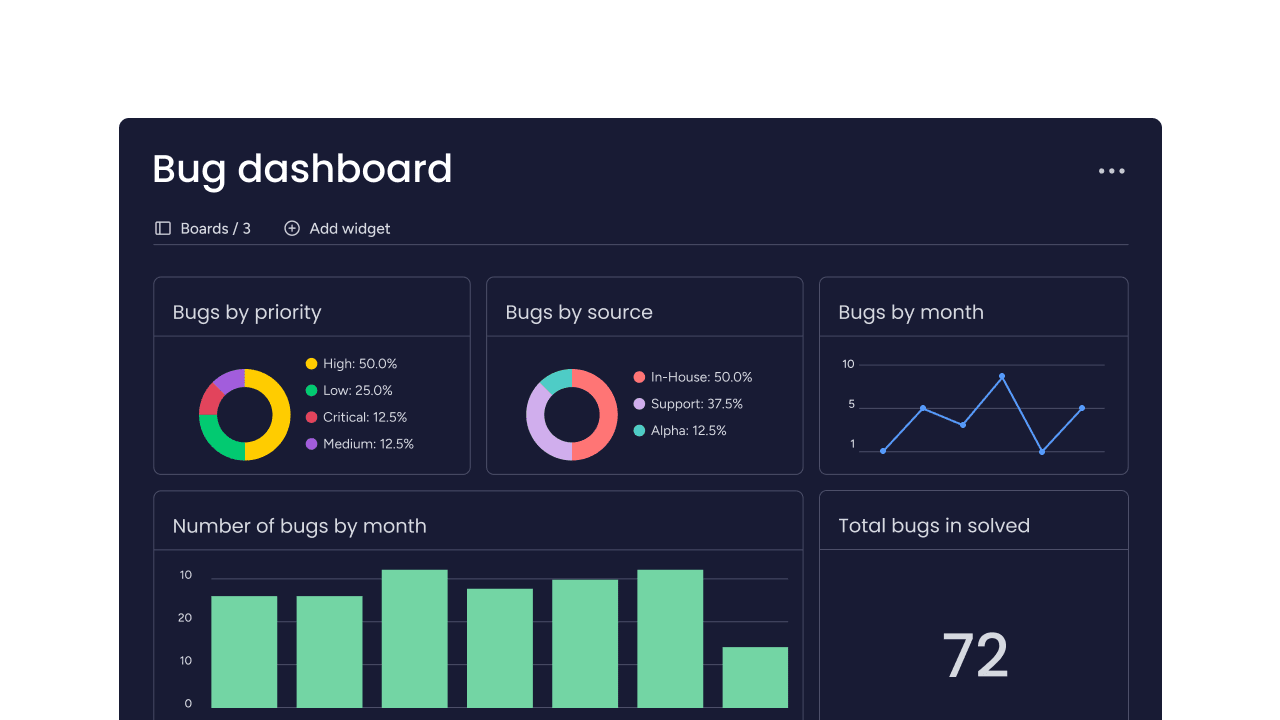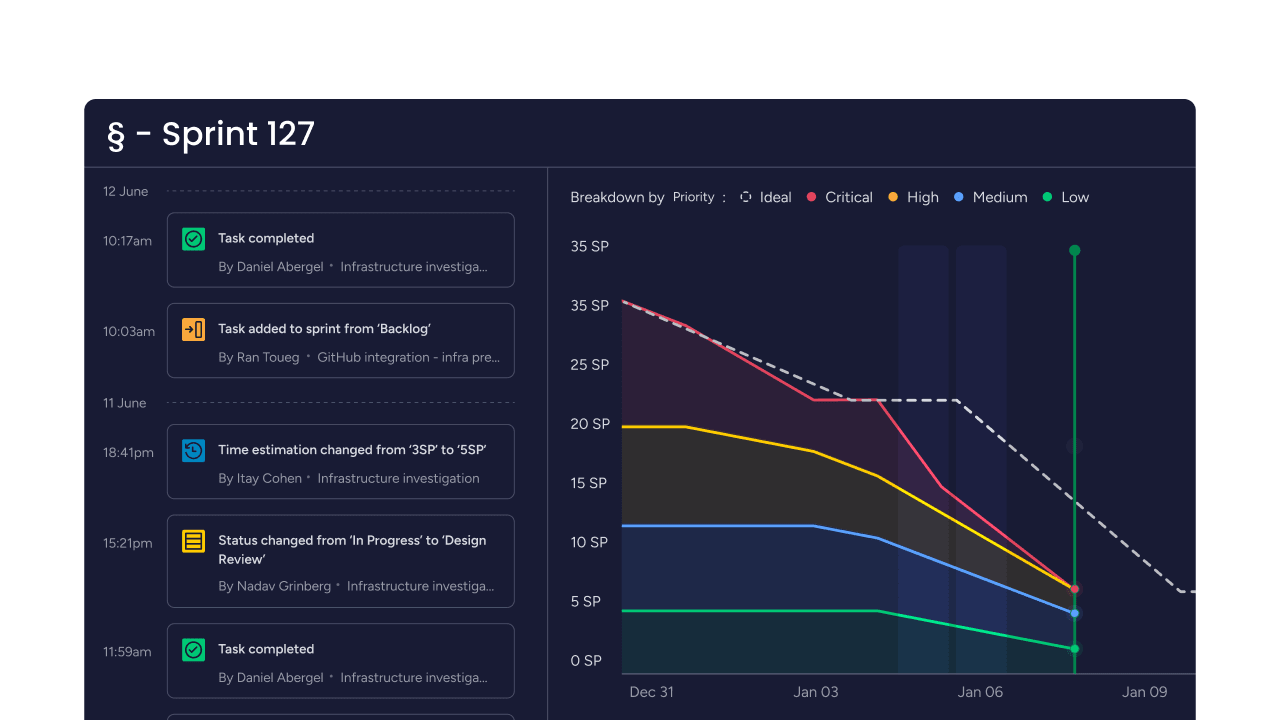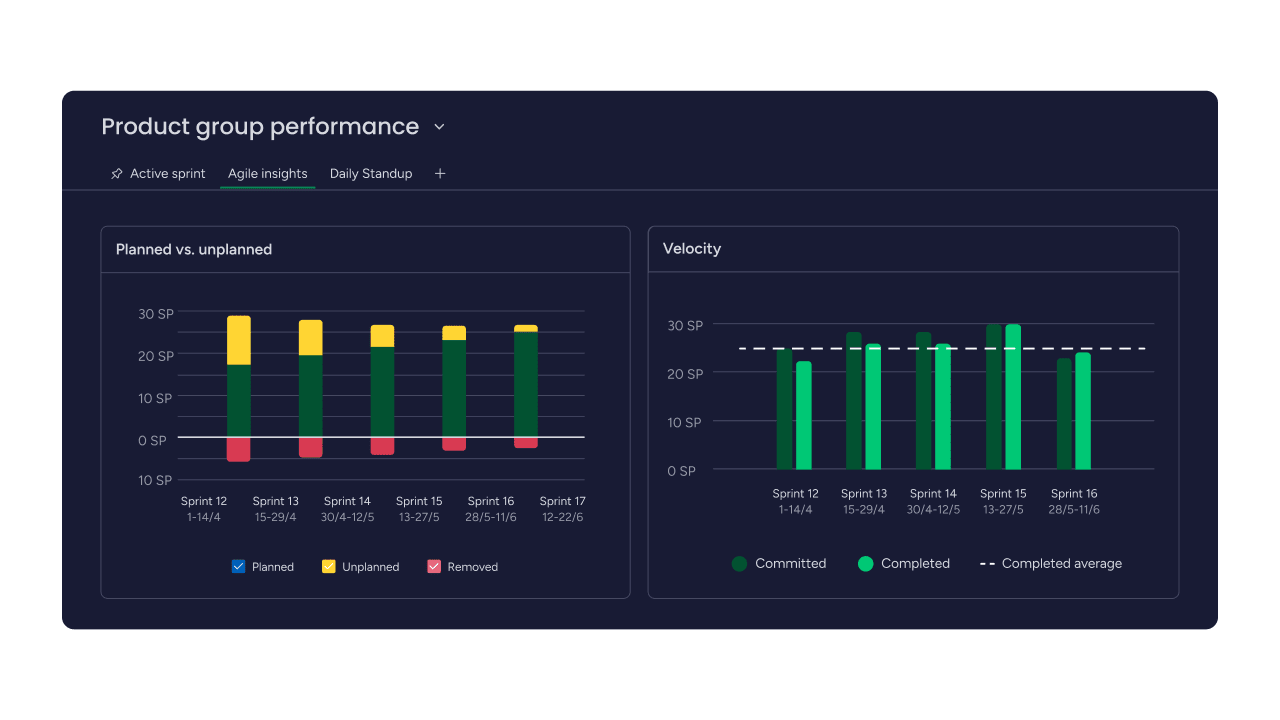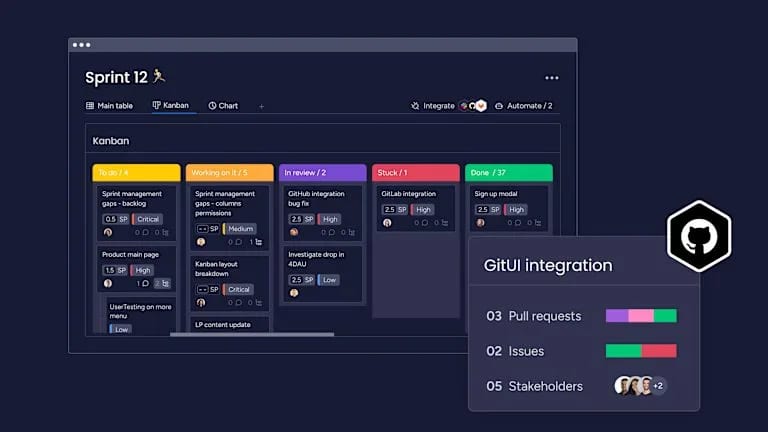A disconnected software development process slows teams down, not the lack of one. When engineering, product, and leadership operate in different systems, work stalls, backlogs grow, and the gap between business goals and what gets shipped widens.
Aligning everyone requires a shared roadmap. A well-defined software development process provides the structure to connect strategy with execution, giving every team member clarity on what to build and why. This guide breaks down the seven key phases of modern development, from initial requirements to long-term maintenance.
The following sections explore how to choose the right methodology, track success with the right metrics, and implement best practices that accelerate delivery. Building a truly effective process is about more than just steps: it’s about creating a single, flexible environment where teams can collaborate seamlessly and deliver with confidence.
Key takeaways
- Requirements analysis is your foundation: spend time upfront understanding exactly what problem you’re solving to avoid building the wrong thing perfectly.
- Choose the right methodology for your team: Agile works best when requirements change frequently, while waterfall suits projects with fixed requirements and compliance needs.
- Centralize your development workflow in one platform: solutions like monday dev help teams maintain visibility across all 7 phases by connecting requirements, code repositories, and deployment tracking in a single workspace.
- Remote teams need extra documentation and async communication: write down decisions that happen verbally in offices and create regular sync points across time zones.
- Track velocity and quality metrics together: measure how much work your team completes per sprint alongside defect rates to ensure speed doesn’t sacrifice quality.
What is the software development process?
The software development process is a structured approach to building software from start to finish. It’s the roadmap that takes you from “we need an app” to “here’s your working software.”
Building software requires blueprints, materials, workers, and quality checks before anyone uses it: just like constructing a house. The software development process guides teams through planning, building, testing, and maintaining applications with the same structured approach.

7 key phases of modern software development
Every software project moves through seven distinct phases. These phases give structure to what could otherwise be chaos when multiple people work on complex technical projects, forming the basis of project management for software development as well.
You’ll use these same seven phases whether you’re building a mobile app or enterprise software. The difference lies in how you organize the work; some teams complete all phases in sequence, while others cycle through them repeatedly in short sprints.
Step 1: requirements analysis and gathering
Requirements analysis means figuring out exactly what your software needs to do. You’re answering the question: what problem are we solving?
This phase involves talking to everyone who’ll use or pay for the software. You’ll document what features they need, how the system should perform, and what counts as success. Platforms like monday dev help teams capture these requirements in one place where everyone can see and comment on them.
Your requirements fall into two main categories:
- Functional requirements: what the software does (like “users can reset passwords”).
- Non-functional requirements: how well it performs (like “pages load in under two seconds”).
Step 2: strategic planning and feasibility
Planning determines if you can actually build what stakeholders want with the time, money, and people you have. You’re creating the game plan for the entire project.
During planning, you’ll map out timelines, assign team members, and identify risks that could derail the project. This phase helps you greenlight projects with a clear path to success by confirming realistic expectations and resource availability.
Step 3: system design and architecture
System design creates the blueprint for your software. You’re deciding how all the pieces fit together before writing any code.
Designers and architects work out the technical structure including which programming languages to use, how data flows between components, and what the user interface looks like. Good design decisions here prevent expensive rewrites later.
Step 4: development and implementation
Development is where programmers write the actual code. This is what most people think of when they imagine software development.
Modern teams break development into small chunks, review each other’s code, and rely on software development tools to track changes. Solutions like monday dev connect with your code repositories to give everyone visibility into what’s being built while protecting developers’ flow state.
Step 5: testing and quality control
Testing ensures your software actually works as intended. You’re looking for bugs, performance issues, and anything that might frustrate users.
Quality control happens at multiple levels:
- Unit testing: checking individual pieces of code.
- Integration testing: verifying components work together.
- User acceptance testing: confirming the software solves the original problem.
Step 6: deployment and release management
Deployment puts your software into the hands of actual users. You’re moving from the development environment to the real world.
This phase requires careful coordination including setting up servers, migrating data, training users, and having rollback plans if something goes wrong. Modern deployment strategies let you release gradually to minimize risk.
Step 7: maintenance and continuous improvement
Maintenance keeps your software running smoothly after launch. You’re fixing bugs, adding features, and adapting to changing user needs.
Software is never truly “done.” User feedback, security updates, and evolving business requirements mean you’ll cycle back through earlier phases, just like in any product development process, to improve the product over time.
Choosing your software development methodology
Organizing these seven phases into actionable workflows requires selecting the right software development methodology. Your chosen methodology determines whether your team completes all phases sequentially or cycles through them in iterative sprints.
Agile software development process
Agile software development breaks the seven phases into short cycles called sprints. Instead of spending months on requirements, then months on design, you do a little of everything every one to four weeks, a hallmark of rapid application development. The U.S. GAO’s 2024 assessment found that 10 of 21 DoD IT programs were developing software using Agile methodologies.
Each sprint in the Agile development process produces working software you can show to stakeholders. This rapid feedback helps you adjust course before investing too much time in the wrong direction. Teams using sprint planning solutions provided by platforms like monday dev can organize these cycles and track progress across iterations, ensuring everyone stays aligned on what’s being delivered.
Traditional waterfall approach
Waterfall completes each phase fully before moving to the next. You gather all requirements, complete all design, write all code, then test everything at once.
This sequential approach works when requirements won’t change and you need detailed documentation for compliance. But it struggles when users aren’t sure what they want until they see working software. Teams often weigh Scrum vs Waterfall approaches to manage shifting requirements.
Hybrid and DevOps integration
Many teams blend approaches to fit their situation. You might use Waterfall for planning but an Agile SDLC for development, or add DevOps practices to automate deployment regardless of your methodology.
DevOps brings development and operations teams together, using automation to speed up deployment and monitoring. This integration helps you deliver updates faster while maintaining reliability, a key principle of Agile project management.

Software development process steps for remote teams
Remote teams face unique challenges in coordinating work across time zones and managing software teams effectively. The seven phases still apply, but you need extra attention to documentation and collaboration.
According to the U.S. Bureau of Labor Statistics, 69.0% of computer and mathematical workers teleworked at least some hours in Q4 2024.
Successful remote development requires:
- Clear documentation: writing down decisions that might happen verbally in an office.
- Asynchronous communication: using platforms that don’t require everyone online simultaneously.
- Regular sync points: scheduling overlap time for real-time problem-solving.
Modern solutions like monday dev provide visibility needed by remote teamts, showing who’s working on what without constant status meetings.
Essential metrics for development success
Determining whether your development process is effective requires measurement and analysis. The right metrics enable teams to identify issues early and make data-driven decisions about process improvements.
- Velocity and productivity tracking: velocity measures how much work your team completes per sprint. It’s not about pushing people harder , but about predictable planning. When you know your team typically completes 50 story points per sprint, you can plan realistic timelines. Tracking velocity over time also reveals whether process changes actually help or hurt productivity.
- Quality and performance indicators: quality metrics tell you if you’re building software that actually works. Track defect rates, test coverage, and customer satisfaction to ensure speed doesn’t sacrifice quality. Performance metrics like response time and uptime show whether your software meets user expectations in the real world. Poor performance drives users away faster than missing features.
- Team collaboration metrics: collaboration metrics reveal how well your team works together. Long code review times might indicate overloaded team members. Low documentation updates could mean knowledge isn’t being shared. monday dev surfaces these collaboration patterns automatically, helping managers spot bottlenecks before they impact delivery.

"monday dev empowered us to optimize our GTM approach, resulting in faster, more dependable deliveries"
Steven Hamrell | Director of Product Management
"monday dev empowers us to manage the entire development process on one platform so we can speed up product delivery and improve customer satisfaction"
Mitchel Hudson | Head of Technology
"We're operating in an open, deep trusting, transparent environment with no silos of information. It's about completely opening access to everyone who needs it."
Alan Schmoll | Executive Vice President, Vistra PlatformBest practices for software engineering process
Looking to strengthen your development process? These proven practices help teams ship quality software more consistently while reducing friction and rework.
Streamlining requirements management
Good requirements management prevents building the wrong thing. Create a single source of truth for requirements where stakeholders can see and comment on priorities.
Use techniques like user stories to keep requirements focused on user value rather than technical specifications. Regular requirement reviews ensure you’re still building what users actually need.
Optimizing your dev process
Process optimization means finding and fixing the parts that slow you down. Run retrospectives to identify what’s not working, then experiment with specific improvements.
Common optimizations include:
- Automating repetitive work: let computers handle routine updates.
- Reducing handoffs: minimize work passing between people.
- Limiting work in progress: focus on finishing rather than starting.
Accelerating testing cycles
Faster testing means faster delivery. Automate repetitive tests so humans can focus on exploratory testing that finds unexpected issues.
Shift testing left by having developers write tests as they code. This catches bugs immediately rather than waiting for a separate testing phase. Connected platforms like monday dev integrate with testing platforms to track quality metrics alongside development progress.
How is AI transforming software development processes?
AI isn’t replacing developers, but making them more productive. Modern development platforms include AI features that handle routine work so humans can focus on creative problem-solving. According to McKinsey’s 2024 Global AI Survey, 65% of organizations were regularly using generative AI in their operations.
Current AI applications include:
- Code completion: suggesting the next lines of code based on context.
- Bug detection: spotting potential issues before code review.
- Test generation: creating test cases based on code changes.
- Project insights: predicting timeline risks based on historical data.

How does monday dev power modern development teams?
Development teams juggle multiple projects, stakeholders, and deadlines simultaneously. Without the right platform, important details fall through the cracks and teams waste time on status updates instead of building software.
These coordination challenges get solved when all aspects of development connect in one flexible platform like monday dev. Teams get visibility without micromanagement, automation without rigidity, and insights without manual reporting.
The platform delivers specific capabilities that streamline every phase of development:
- Sprint planning boards: organize backlogs, plan sprints, and track velocity with customizable views that adapt to your team’s workflow.
- Git integration: connect GitHub, GitLab, or Bitbucket to automatically sync code changes with tasks, giving stakeholders visibility without interrupting developers.
- Automated status updates: let AI surface project insights and generate progress reports, freeing developers from manual updates.
- Bug tracking and QA workflows: manage defects from discovery through resolution with customizable severity levels and automated routing.
- Release management: plan deployments, coordinate rollouts, and track post-release issues in one centralized view.
- Cross-team dashboards: give product, engineering, and leadership real-time visibility into progress, blockers, and resource allocation.
Whether you use Agile, Waterfall, or something in between, monday dev’s customizable workflows support your approach while maintaining consistency across projects. The platform adapts to how you work rather than forcing you into a predetermined process.

Start building your ideal software development process
The seven phases of software development provide a foundation, but success comes from adapting them to your team’s needs. The right combination of methodology, practices, and platforms enables consistent delivery without sacrificing quality or burning out your team.
Modern development requires flexibility, visibility, and coordination across diverse stakeholders. Teams that master these elements deliver valuable software that meets user needs and business goals.
Frequently asked questions
How long does each phase of the software development process typically take?
The time each phase of the software development process takes varies based on project complexity and methodology. In waterfall projects, requirements and design might take weeks or months, while Agile teams cycle through all phases in one to four week sprints. Simple projects might move through all phases in weeks, while enterprise software can take years.
What's the most important phase in the software development process?
Requirements analysis is often the most critical phase because building the wrong thing perfectly still results in failure. However, all phases interconnect: poor testing leads to buggy software, while weak maintenance causes user frustration over time.
How do you handle scope changes during the software development process?
Handling scope changes depends on your methodology. Agile embraces change through regular sprint planning and backlog refinement. Waterfall uses formal change control processes to evaluate impacts on timeline and budget before approving modifications.
What roles are essential for the software development process?
Essential roles include developers who write code, product owners who define requirements, designers who create user interfaces, testers who ensure quality, and project managers who coordinate everything. Smaller teams might have people wearing multiple hats.
How does the software development process differ for mobile vs web applications?
Mobile development adds platform-specific considerations like app store requirements, device testing across multiple screen sizes, and offline functionality. The seven phases remain the same, but design and testing phases require additional attention to platform constraints.
What happens after the software development process is complete?
Software development never truly ends; the maintenance phase continues as long as people use the software. Teams monitor performance, fix bugs, add features based on user feedback, and eventually plan major updates or replacements when technology evolves.
 Get started
Get started 

